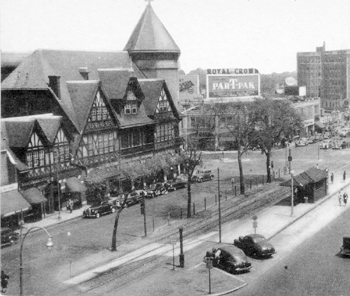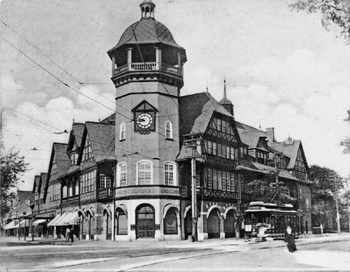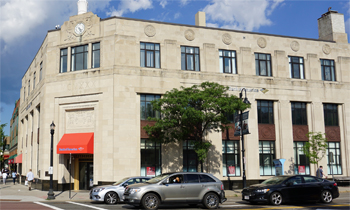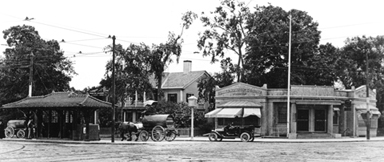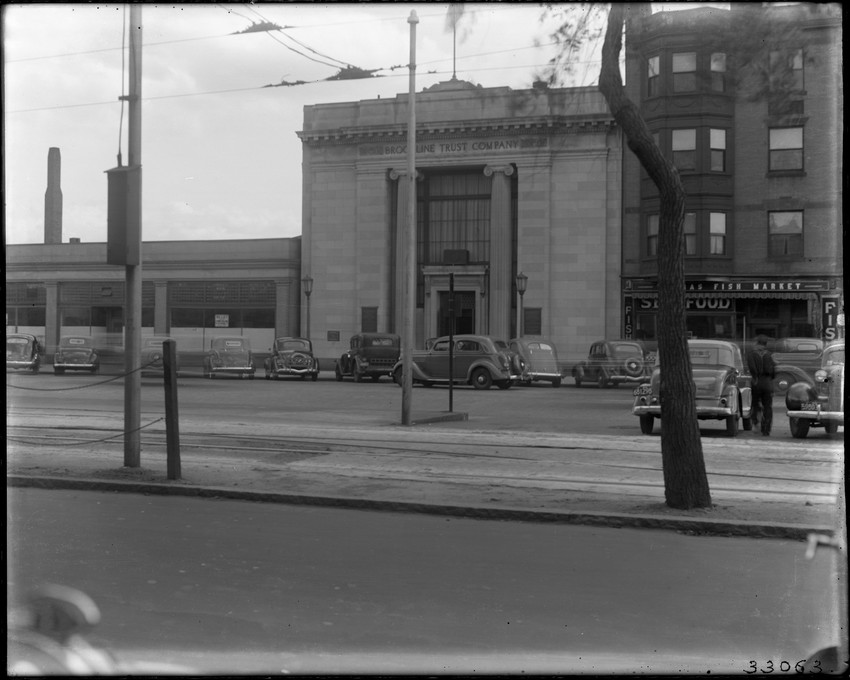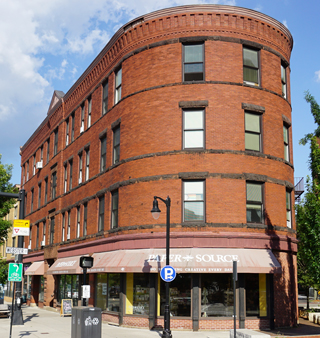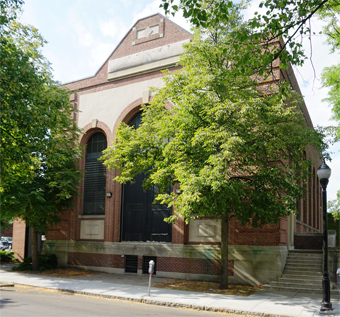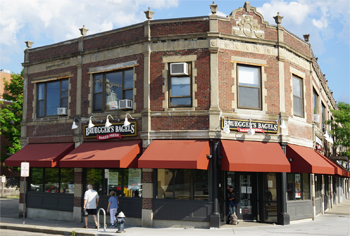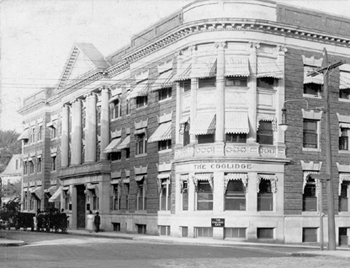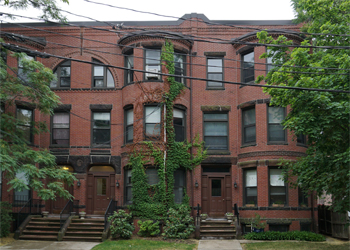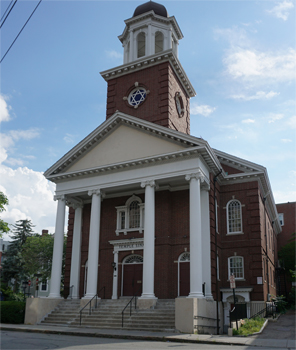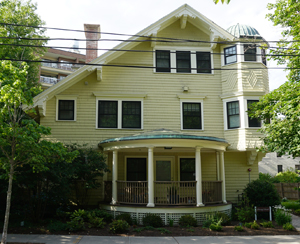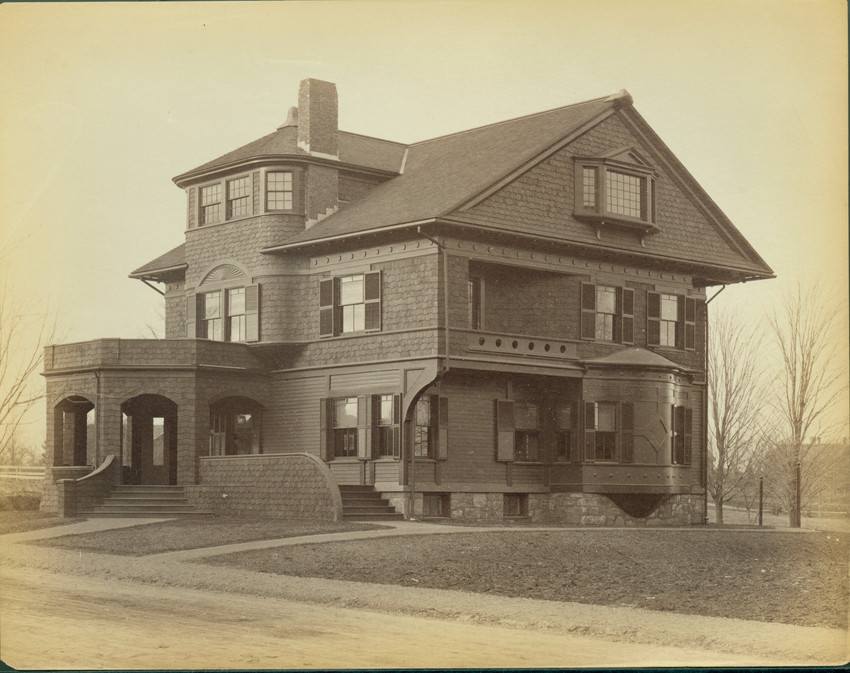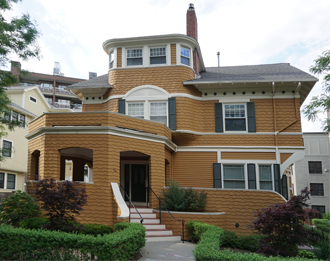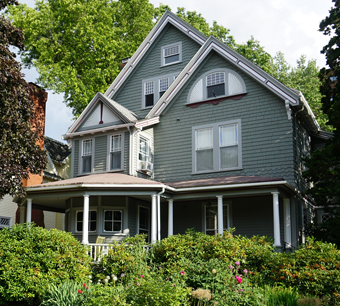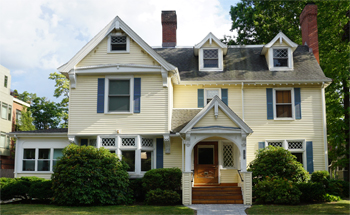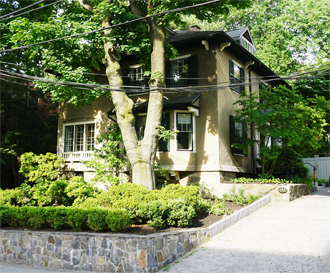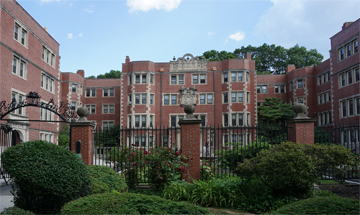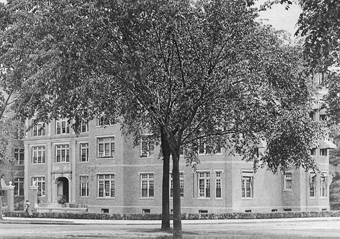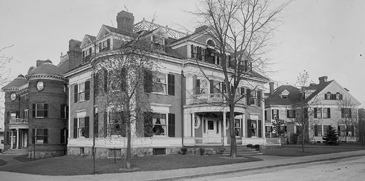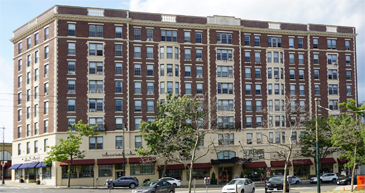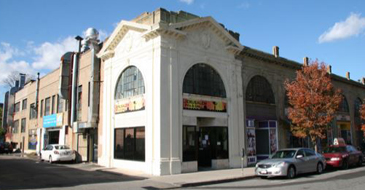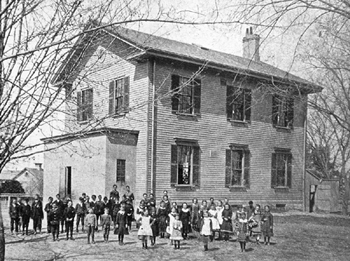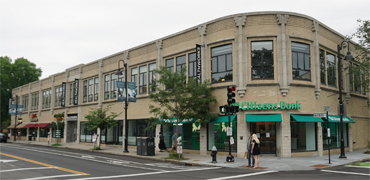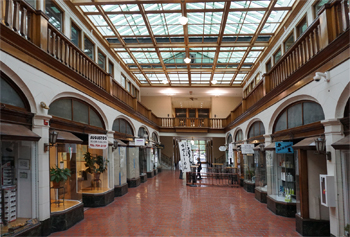Courtesy, Brookline Preservation Commission
See also:
Tour One takes in the vicinity of Coolidge Corner along both Beacon and Harvard Streets and three other streets to the south and east. Before Beacon Street was widened and the electric streetcar introduced down its length, the history of Coolidge Corner was the history of its farming families: the Coolidges, the Griggses and the Stearns. Almost all of the land covered in this tour belonged at one time to them.
[1] The tour starts at the northwest corner of Beacon and Harvard Streets, in front of the old S. S. Pierce Building, which faces both Beacon and Harvard Streets. Built during 1898-99, the structure is so placed that it is highly visible along Beacon Street from both the eastern and western approaches, thereby constituting a landmark in the Town. This building, with its polygonal tower, dominates the intersection and has come to symbolize Coolidge Corner. Its architectural style, utilizing stucco and half timbering with a steep slate roof and an asymmetrical facade with many gables and dormers, is derived from Medieval English or German public buildings. The architects were Winslow and Wetherell, partners in a well-known Boston firm, who were engaged by Wallace Pierce, son of the S. S. Pierce Company's founder, to design a suburban store for the importers and purveyors of fine groceries. The S. S. Pierce Company opened in 1831 on Tremont Street in Boston, later adding a branch at Copley Square. Wallace Pierce saw the opportunity for expansion in the rapidly growing Coolidge Corner area; indeed, within six years of Beacon Street's widening the population along the boulevard had increased by a third. The building's original tower was taller, with a bellcast roof surmounting an open belvedere. Weakened by the 1944 hurricane, the tower roof and superstructure were changed to their present shapes in the following year. The first-floor storefronts, of course, have undergone many changes, as has the interior of the building. Originally most of the second floor was occupied by Whitney Hall, named for the developer of Beacon Street. The Chronicle of October 28, 1899 described the "Splendid New Audience Room at Coolidge Corner", to be let for theatricals, concerts, lectures, and parties; there was a stage as well as banquet and reception halls. All of this space was later converted to offices. The S. S. Pierce Building replaced the Coolidge & Brother store of 1857, founded by David Sullivan Coolidge, and his cousins Thomas B. and William J. Griggs, on Griggs land. This building, serving for many years not only as a general store but as a meeting place for the neighborhood, provided the name for the intersection of Beacon and Harvard Streets, which was called Coolidge's Corner until the early 1900's. William D. Coolidge, David's brother, managed the store until his death in 1884, at which time it was sold to the grocery concern of Merrill V. Brown & Company. It was from this firm that Wallace Pierce purchased the original store in 1892, later moving it to the west to provide space for loading delivery wagons. The firm maintained its store here until the late 1960's; the building is now occupied by a number of shops on the first floor and offices at the upper levels. [2] Cross Beacon Street now to the center island, where, on either side of Harvard street, stand two open-sided, tile-roofed transfer stations. These are the original shelters, built in 1901 by the West End Street Railway, and are the only such structures on Beacon Street remaining from that period. They are now owned and maintained by the MBTA, as part of its Green Line. [3] Diagonally across from the S. S. Pierce Building is the Bay Bank Norfolk County Trust Company building, a fine example of the Art Deco style and almost the only one of its type in Brookline. Designed by J. Williams Beals's Sons in 1930 for the Boulevard Trust Company, this building, of Indiana limestone with a polished granite base, exhibits the linear, hard-edged low relief ornamentation characteristic of the style. The windows, separated by flat fluted pilasters, give a vertical emphasis to the design. Note the stylized decorations over the doorway and surrounding the third story clock, as well as the disks at the parapet and the representations of ancient coins on the metal spandrels between the first and second floors. The interior of this bank, done in French shell limestone, marble, and teak, is also executed in the Art Deco style and is practically unchanged. The heavy bronze doors, writing desks, tellers' grilles, light fixtures, ceiling fans, and paneling are all original, as is the coffered ceiling with a geometric decoration which is repeated in marble around the perimeter of the main floor. Incidentally, this building represents the second growth period at Coolidge Corner, that of the 1920's and 30's, just as the S. S. Pierce Building represents that of the 1890's. The Sewall-Stearns house stood east of the present bank for about one hundred and seventy years. Built c. 1767 by Henry Sewall, grandson of Chief Justice Sewall of Salem witchcraft fame, the house and thirty-three surrounding acres were purchased in 1819 by Charles Stearns, the first of three of that name. His grandson, Charles H. Stearns, retained this land until his death in 1935. When Beacon Street was widened the house was moved back four hundred feet to the position shown in the 1926 photograph [Editor's Note: earlier photograph show here]. It is behind the structure which Charles H. Stearns built as a real estate office, with a 1910 addition for a bank, the Boulevard Trust. Stearns sold his bank in 1920 to a corporation which later merged with other banks to become the Norfolk County Trust. [4] Next, walk west along Beacon Street to #1341, the Brookline Trust Company. This bank had its beginnings in Brookline Village at the turn of the century and built this impressive branch in 1919, responding to the growing needs of the Coolidge Corner area. The architect, Thomas M. James, was the designer of Boston's Shubert Theater and well known as a designer of banks. The massive Neoclassical facade, relieved only by the tall central window flanked by Ionic columns, was intended to express stability and reliability. The interior is of Tavernelle marble, hung with six Gobelin tapestries woven in the last quarter of the 17th century after designs by Lucas van Leyden of Holland. These were given to the bank by one of its early directors and presidents, Ernest B. Dane. [5] A little further west on Beacon street, at #1355-63, is The Willard, a large brick four story building. William D. Coolidge's house stood on this spot until it was moved when Beacon Street was widened. The Willard was built in 1890 by John W. Shapleigh, a local real estate dealer who lived farther west on Beacon Street. Samuel D. Kelley, who designed many Boston apartment houses in this era, was the architect. The design features a terra cotta relief in the central pediment, panel brick corbeling at the cornice, a rounded corner, and brownstone banding at each floor. The building's use, with shops on the first floor and apartments above, continues unchanged to this day. [6] Leaving Beacon Street, turn left onto Webster Street and proceed to the large brick structure on the left. Constructed as a generating plant or sub-station for the Boston Elevated Railway Company, it is now owned by the MBTA [Editor's Note: powers the Green Line]. The massive construction of the building, with heavy brick quoins at the corners and arched windows several stories high, emphasizes its use as housing for power-generating equipment. It was designed in 1911 by the firm of Peabody and Stearns, of which both principals were Brookline residents. It should be noted here that a great many of the architects practicing in the Boston area lived in Brookline; of the buildings mentioned in this tour alone, nine were designed by Brookline residents. [7] Continue down Webster Street and cross Harvard Street. At #229-33 is a brick building which, like The Willard, has a rounded corner where two streets intersect at a sharp angle. Here the first-floor level at the corner is faced with limestone, and a heavy Romanesque arch marks the entranceway. The owner, Peleg Briggs Wadsworth, ([see Tour 2]) built this to house six apartments; it has since been converted to offices. [8] Nearby, at the intersection of Sewall Avenue and Stearns Road (both named, of course, for the two families which had owned this land, for so many years) stands The Coolidge, at #9 Sewall Avenue. It is located on the site of a house built by the second Charles Stearns c. 1828. When that house was moved down the road to make way for The Coolidge, it was discovered that the 1729 milestone, now across the street in front of the Harvard Street Church (see the [Coolidge Corner West] tour), was being used as a front doorstep. The architect of The Coolidge, T. Edward Sheehan, also used limestone to face a rounded corner, as seen across the street, but here it extends the full height of the building. His design uses many Neo-Classical elements, including a pedimented portico, Ionic columns and pilasters, a parapet, and large single-pane sashes. The Coolidge was built for "bachelor apartments", that is, full kitchens were not provided but there was a large dining room where residents could take their meals.Sewall Avenue is one of Brookline's old roads, having been laid out early in the 18th century as "The Road to the Marshes". The land at the marshes, between the Charles and Muddy Rivers, was apportioned in fairly small parcels among the early settlers and was valued as a source of hay. Continue down the street to Longwood Avenue, turning right at the corner. This street was laid out in 1857 and named for David Sears's estate. Sears was a great admirer of Napoleon, who, after being exiled to St. Helena, lived with his retinue in the Lieutenant-Governor's residence, Longwood House.
[9] At #27-33 Longwood Avenue stands an unusual brick and brownstone apartment house which was originally constructed as four single family attached houses. Another such block stands farther down Longwood Avenue at #101-105, and yet another is included in Tour 2. Interesting details here are the three-story rounded bay with a domical copper roof and the decorative panel brick details at the cornice and above the third floor windows. [10] Return to Sewall Avenue, turning right towards Charles Street. This was originally called Stearns Street, but was renamed in 1885 for Charles Stearns, through whose property the street was cut. At the corner of Charles Street is the handsome Georgian building of Temple Sinai. A classical brick structure, with a pedimented portico, Ionic columns, tall arched windows and a tower topped by a cupola, it was designed in 1916 by the architect Edwin J. Lewis for the Second Unitarian Society, which had formed in Brookline in 1896. Temple Sinai, which purchased the building from the Unitarians, was founded by a Reform Congregation which first met in Brighton in 1939. The congregation dedicated the sanctuary on Charles Street on September 8, 1944. The Temple lists a number of "firsts" in its founding and its history, relating to Sabbath eve services, equal membership and voting privileges for women, and equal seating privileges for all members. Just across Charles Street, still on Sewall Avenue, are three residences [Editor's Note: only two remain] which serve as excellent examples of the sort of homes which were built in the 1880's and 90's near Beacon Street. All represent the type of substantial suburban house which merchants and professional men were building in Brookline at that time and remind us of the way all the surrounding streets looked before so many houses were demolished to make way for apartment houses and parking lots.[11] Number 64 Sewall Avenue [Editor's Note: no longer standing] is a large house with some elements of the Georgian Revival style; it has a combination hip and gable roof and a latticed front porch next to a first-floor bay window. It was built in 1890 by Edward Russell, a Boston broker. [12] Next door at #70 is an unusual house, designed in 1899 by Julius A. Schweinfurth, architect of three houses on these tours. This one, built for Charles P. Flagg, a Boston liquor merchant, has a fine small two story polygonal bay with a domical roof and finial, tall chimneys, a gable roof supported by heavy brackets, and a long slope to one side of the roof; the building combines elements of both the Queen Anne and Shingle Styles. Schweinfurth, who lived on Webster Place in Brookline Village, was for many years chief draughtsman for the firm of Peabody and Stearns. He went into practice for himself in 1895 and designed a number of buildings for the Town of Brookline; of these, only the Pierce Primary School remains.
[13] Next, at #76-78 Sewall Avenue, stands another singular house. Built in 1885 for George Dexter, a partner in a paint and oils firm, it combines many elements to produce an interesting and somewhat eccentric appearance. Note the squared bay rising above the roof, the chimney let through the roof cornice, and the overhanging side gable with a heavy curved bracket. The facade is richly textured with staggered butt shingles, banding, and bevel siding.
[14] From here, cross St. Paul Street to #97 Sewall Avenue, built in 1886 for Waldo Stearns, treasurer of the A. T. Stearns Lumber Company, a Boston concern. His house was built on a large lot, and its barn still stands at the back. Partly because of this, the house, with its broad front porch, has the air of a rural or small-town residence. The balanced grouping of the three front gables, one decorated with a sunburst pattern, one with fan designs flanking a window, and the third with an interesting arrangement of windows, and the three panel brick chimneys are worthy of note, as are the three different patterns of shingling used. [15] Next door at #103 Sewall Avenue is another Schweinfurth design. This was built in 1893 for Charles D. Hammer, manager of a life insurance company. ([See Tour 2]) for another house by the same architect, designed for Hammer's brother.) Both were built in the Medieval Revival style; here flared bargeboards on the gables and dormers, drop pendants, and diamond-paned windows are prominent features. While this house is now covered with vinyl siding, originally it probably was shingled. [16] Finally, at #109 [Editor's Note: no longer standing], is the last of the single-family houses on this side of Sewall Avenue. It was built in 1885 for Gordon Plummer, a partner in a leather company. Also situated on a large lot, it features two patterns of shingles, an interesting version of a Palladian window in the gable peak, and decorative pargetting over the entrance portico. [17] Turn back to St. Paul Street (named for St. Paul's Church which was built in 1850 at the corner of Aspinwall Avenue and St. Paul Street). As you walk down the hill, notice the second house from the corner, #153 St. Paul Street. This hipped-roof stucco house was the home of the architect Joseph B. Gay and was designed by his firm, Gay and Proctor, architects of a Beacon Street apartment house on this tour. [18] At Beacon Street turn right, continuing down the street to the handsome four-story brick courtyard apartment house at #1209-1217. This is Richmond Court, designed by the firm of Cram, Wentworth and Goodhue, and, according to Douglass Shand Tucci in his book Built in Boston, very probably the prototype in the Richmond Court northeastern United States for courtyard apartment houses built in the style of the great Tudor mansions. The courtyard itself, laid out like a small private park, has a circular driveway and a fountain adorned by a bronze nymph and is set off from the street by an iron railing, brick and stone posts, and arched gateways. The building, detailed with limestone quoins, window sills, and lintels, also has fine carved stone decorations over the center entrance. Divided into five "halls": Grafton, Lennox, Gordon, St. Alban's and Portsmouth, each with its own entrance, Richmond Court was built with forty units each consisting of nine rooms which, due to the building's design, all had access to light and fresh air. In 1898, the year Richmond Court was built, the architect Ralph Adams Cram was not well known but he became one of the nation's leading ecclesiastical architects, designing the Cathedral of st. John the Divine in New York City, the beautiful All Saints Church in Ashmont, Dorchester, and All Saints Church in Brookline. In addition, he was the architect of many of the buildings at the United States Military Academy at West Point and at Princeton University. In 1903, Cram lived at Richmond Court; other residents included lawyers and publishers. For some time it was considered one of the more fashionable addresses on Beacon Street. [19] Turning back towards St. Paul Street, take note of Hampton Court, at #1223 Beacon Street. It is a building obviously inspired by its neighbor, Richmond Court, in size, style, building materials, and type. However, Hampton Court, designed in 1903 by Charles E. Park (see Tour 3), makes no real use of the courtyard concept, and Park has put some rather superfluous battlements at the roofline of his Tudor manor. When built, it contained forty-three apartments and a restaurant.These two buildings stand on land bought from Charles H. Stearns and his uncle Marshal Stearns, for whom nearby Marshal Street was named. The Stearns land, reaching from Harvard Street to Kent Street, had been used for years for market and dairy farming and then as a nursery, as the accompanying advertisement indicates, but by the 1880's Charles Stearns was already supervising the development of a good part of it.
[20] Crossing St. Paul Street, continue up Beacon to #1253, an apartment house named for its original owner, James C. Littlefield, a Boston tailor. This 1907 Federal Revival design, originally built as six apartments, is almost identical to several houses on Boston's Beacon street facing the Common. Its fine details include a balustrade, dentils and modillions at the cornice, limestone lintels and trim; and a fanlight and slender columns at the entrance. [21] Almost directly across Beacon Street at #1258-64 is an apartment house built in 1928. Its architect, F. A. Norcross, designed over forty apartment buildings in Brookline between 1910 and 1930, many of them near Coolidge Corner. Typically, these have heavy, Baroque or Renaissance-inspired limestone entranceways and lintels. Here, Norcross's design is restrained, with few decorative details aside from the handsome treatment of the doorways. The building is given a horizontal emphasis by the placement of the windows and the limestone belt courses. These buildings contain eight units each, with two apartments on each floor. [22] Next door at #1272 Beacon Street is a building as exuberant as its neighbor is restrained. Also designed in 1928, it bears little relation to #1258-64, being constructed of variegated bricks, with a rusticated stone facing at the first floor and Spanish Baroque elements, including twisted columns and curvilinear gables, at the entranceway and fourth floor. The architects, Gay and Proctor, designed many apartment houses in Brookline, often using Baroque details. [23] Across Beacon Street at #2 Charles Street, stands a fine example of the Colonial Revival style residence and one of the very few buildings constructed as a single-family house to remain standing on Beacon Street. (It now contains doctors' offices. Built in 1889 by Alexander Sears, a wholesale grocer, this house is larger and more impressive than the neighboring Sewall Avenue houses of the same era, and it has excellent details both in the windows surrounding the front door and in the central pedimented dormer. [Editor's Note: from the platform on the top of his house Sears took invaluable photographs of the area that are online at the Smithsonian. [24] Pelham Hall, at the corner of Beacon and Pleasant, is the tallest building in the immediate area. Eight stories in height, it contained eighty-five apartments when built, with ten stores at ground level, and in the latter respect it followed the tradition of earlier Beacon street buildings like The Willard. The restrained classical details, now painted gray, are fashioned of limestone and were originally white. This building was designed in 1926 by Arthur H. Bowditch, a lifelong Brookline resident and an extremely versatile architect whose other Beacon Street designs include its grandest courtyard apartment house, The Stoneholm; the Italian Renaissance style Colchester; and the fine attached town houses at #s 1796-1812 Beacon Street. Pelham Hall, like many other Beacon Street apartment houses, was considered a good address, and doctors, brokers, writers and merchants were tenants here the first year after it was built. A plaque in the building marks it as the first American residence of Arnold Schoenberg, the Austrian composer. [25] Around the corner at #s 10- 18 Pleasant Street stands a concrete building which houses shops along the street and a garage. It was built in 1926, like many other Coolidge Corner buildings, and its use then was the same as it is now. Originally the Durgin Garage sported a balustrade at the roofline, topped by urns at either side of the classical 1926 Advertisement pediments. While the urns have disappeared, large two-story arched windows still delineate each bay, and cartouches and swags still decorate the pediments in this design by Harold F. Kellogg. This was the site of the house bought in 1860 by General James S. Whitney, which was home for a number of years to his son, Henry M. Whitney (see Introduction). By the start of the 19th century, Pleasant Street was laid out leading from Harvard Street to the Charles River. By 1820, here, as on the other side of Beacon Street, the land was owned by members of the Stearns family. Where John Street joins Pleasant stood the home of John G. Stearns Sr., for whom John Street was named, and next door, on what is now a vacant lot, was the home of his son John Goddard Stearns, of the architectural firm of Peabody and Stearns. This Italianate house served for many years as the Brookline Post of the American Legion. Across the street was located the home of James P. Stearns, a banker and the brother of Charles H. Stearns. His Mansard house was used as the Coolidge Corner branch library for many years after his death, and its site is now occupied by the present library building. When Stearns's original holdings were broken up in the 1920's, James Street was laid out through his former property, becoming the fifth street in the Town to be named for a member of that family. Now retrace your steps to Beacon Street, walking towards Harvard Street. On your left, very near the tile-roofed transfer station in the middle of Beacon Street, is the site of the Beacon Street schoolhouse which stood here for forty years. It was built about 1852 on a triangle of land created by the intersections of Harvard and Pleasant Street with the newly built Beacon Street and was torn down in 1889 when that street was widened. The Devotion School (see Tour 3) replaced it. James W. Coolidge, a brother of David S. Coolidge, was caretaker of the school for many years. [26] The corner of Harvard and Beacon Streets opposite the S. S. Pierce Building is defined by a two story pre-cast concrete and brick structure which fronts on both streets and serves now, as it did when it was built, to house commercial enterprises on the first floor and offices on the second. This 1912 design by Arthur H. Bowditch has a curvilinear gable over its corner entrance and wide arched windows marking each bay. Note, along the Beacon street side, how careful attention to sign design helps to unify the building's facade and emphasize its architectural features.
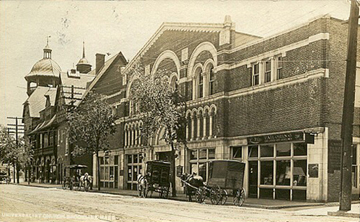
This area is fortunate in having two commercial 1930' s buildings, The Arcade and the Bay Bank Norfolk Trust, which have relatively unaltered interiors, allowing us to see the entire structures as their architects and original owners built them.
© 2020 Brookline Historical Society
